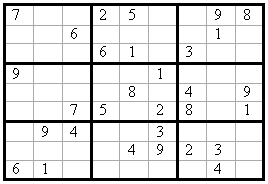| Submit | All submissions | Best solutions | Back to list |
SUD - SuDoku Puzzle |

Unlike in magazines and newspapers, the digital representation of Sudoku a puzzle is a string of length 81, with all rows of the puzzle placed one after another. The representation uses ASCII symbols ‘1’-‘9’ for digits and ‘.’ for an empty space. For example, the puzzle from figure above can be represented as:
7..25..98..6....1....61.3..9....1.......8.4.9..75.28.1.94..3.......4923.61.....4.
In this task you are to solve such puzzles automatically. The score will depend on the number of solved puzzles and on the speed of your solution. Some of the puzzles have multiple possible solutions, so be careful. A solution is correct if it satisfies the given puzzle. You can be sure that all given Sudokus are correct.
Input
t – the number of test cases; then t test cases follows. [t <= 500]
Each test case describes one SuDoku puzzle and consists of an 81-character-long string.
Output
For the i-th test case output a line containing Y if you want to solve the test case or N if you wish to leave it out. If you chose to solve the test case, in the next line output a sequence of exactly 81 characters corresponding to the solution for the i-th Sudoku puzzle.
Score
The score for this task calculated using the formula: score = 200*total_solved/(200+time), where total_solved - number of correctly solved puzzles, time - running time of your program. If the score has the following form: xxx.xxxaaa, then aaa - is the number of correctly solved puzzles.
Example
Input: 3 ..41..3.8.1....62...82..4.....3.28.9....7....7.16.8...562..17.3.3.....4.1....5... 1.......4....1.38.27.9.4...91.7...........5..86.4.5.9..3......8..9....2.4.......7 7..25..98..6....1....61.3..9....1.......8.4.9..75.28.1.94..3.......4923.61.....4. Output: Y 294167358315489627678253491456312879983574216721698534562941783839726145147835962 Y 198563274654217389273984615915726843347198562862435791731642958589371426426859137 N Score: In this case total_solved = 2. If the program runs for 10 seconds, then the score of this solution will be equal to 1.905002
| Added by: | Roman Sol |
| Date: | 2006-03-30 |
| Time limit: | 24.05s |
| Source limit: | 100000B |
| Memory limit: | 1536MB |
| Cluster: | Cube (Intel G860) |
| Languages: | All except: ASM64 C++ 4.3.2 ERL JS-RHINO NODEJS OBJC PERL6 SQLITE VB.NET |
| Resource: | ZCon 2007 |
hide comments
|
|||||
|
2009-10-19 15:49:35 Wolfram
I always get "internal error". Why? Edit: Works again - thanks! Last edit: 2009-10-20 14:59:00 |
|||||
|
2009-10-19 15:49:35 Alex Palmer
I am a little confused about why you would output 'Y' or 'N'. Isn't the point of this to solve every one given? |
|||||
|
2009-10-19 15:49:35 Omar ElAzazy
"A solution is correct if it satisfies the given puzzle" does that mean any correct soloution is Accepted ? |
|||||


 RSS
RSS